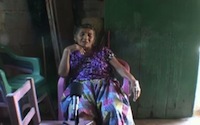Welcome to the electronic archive on the language and culture of the Lowland Chontal community of southeastern Mexico. Each tab on this page gives a brief introduction to some aspect of the documentation project, with language as the focus of this first tab. The corpus itself has descriptive linguistic materials in nodes 08 Language and 10 Dictionaries.
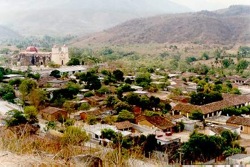 Church of San Pedro, Huamelula |
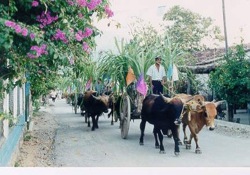 December parade, Huamelula |
Language and speakers – Lengua y hablantes
Lowland Chontal of Oaxaca is an indigenous language of southeast Mexico, spoken primarily in and around San Pedro Huamelula and Santiago Astata near the coast of the state of Oaxaca. There are perhaps some 100 fluent first-language speakers, all older than 70, and perhaps another 1000 semi-speakers, all older than 50. So far as we know, there are no monolinguals in Chontal and no bilinguals in another indigenous language. All speakers of Lowland Chontal are also speakers of Spanish.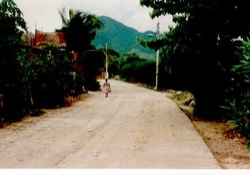
Woman on street, Huamelula
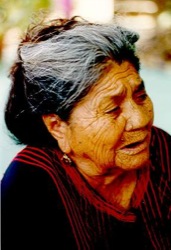
Romana García Aguilar |
 Arturo Pétriz Muñoz |

Petrona Sosa García |
Genetic profile – Perfil genético
The language is a variant of Chontal of Oaxaca, a small family of unclassified languages sometimes associated with the proposed Hokan stock, of western and southwestern United States and northwestern Mexico, and/or with the Jicaque (Tol) family, of Honduras. There is a sister language, Highland Chontal, with some 3600 speakers and semi-speakers (www.ethnologue.com) in similarly endangered circumstances. Other names in the literature for Lowland Chontal are Coastal Chontal or Huamelulteco, while Highland Chontal is also called Chontal of the Sierra or Tequistlateco. A third member of the Chontal of Oaxaca family, once spoken near the town of Tequisistlán and also called Tequistlateco, is now extinct. None of these languages are related to Chontal of Tabasco, which is a Mayan language.
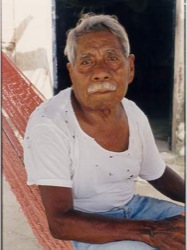
Alberto Espinoza López |

and daughters Eulalia, Adelaida, |
Other documentary work – Otro trabajo documental
Both Lowland and Highland Chontal were documented by linguists from the Summer Institute of Linguistics: Viola Waterhouse lived and worked periodically with speakers in the coastal lowlands from 1942 through the 1970s, and Paul and Shirley Turner worked in the highland communities 1959-1963.
Our documentation project deals exclusively with Lowland Chontal. In 2010, a different group of investigators has begun a project with Highland Chontal.

Chontal ladies |

Chontal ladies |

Inéz Zavaleta and her after-school class
During the 1990s, the local branch of the Indigenous National Institute sponsored a language-renewal initiative Aprendo Chontal con La Abuela, ‘I Learn Chontal with Grandmother’. There is a nominal bilingual education program of some 70 primary school teachers, but this has achieved limited results. Enterprising second-language speakers have produced a DVD of traditional dances, a CD or two of popular music and a CD of children singing Chontal translations of Mexican patriotic songs.
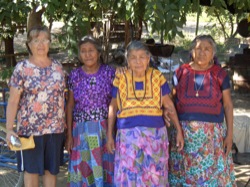
Sara de León, Adelaida Espinoza, Columba Ramírez, Antonia Pomposo
Typological profile – Perfil tipológico
Chontal is a verb-initial head-marking language, with variable word order, a complex system of aspect, and no case or tense markers. The primary person-marking paradigm is an agent-patient system motivated by perceived control or intention over change of location, change of position or change of state. Two types of complex verb constructions provide rich detail of spatial and temporal features of change events, patterns which have led to interesting neologisms and grammatical changes in the local Spanish.
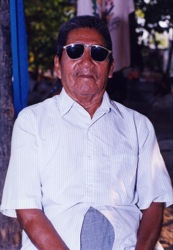
Anacleto Castro Méndez
Chontal is a predominantly synthetic language in that derivational and inflectional morphemes bind to roots to form single words. Agglutination is the most common word-building strategy, and most words are easily analyzable into recognizable morphemes, which include roots, affixes and clitics. Nominal morphology is mostly prefixing, and verbal morphology is mostly suffixing. The language has a few infixes, which are inserted into the nominal or verbal root. Most nouns and verbs are synthetic, formed of a root plus a variety of affixes. Clitics attach to either end of various classes of words; they attach to each other, forming polyclitic words, and they can occur alone. The sound system is characterized by series of glottalized consonants and pervasive palatalization.

Crysanthemums on a bus, getting ready for All Saints´Day |

Gabriel Rey Reyes |
Spanish words have entered the language as nouns, a few verbs, and especially as closed-class grammatical morphology.
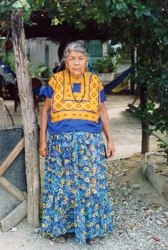
Columba Ramírez |
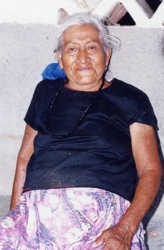
Hermenegilda García Trinidad |

